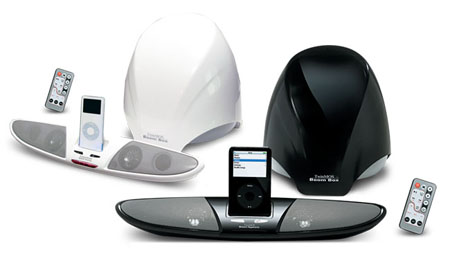Original URL: https://www.theregister.com/2007/09/14/review_boom_audio_system/
TwinMos Boom 1 2.1-channel iPod audio system
This could be the walrus
Posted in Personal Tech, 14th September 2007 12:00 GMT
Review The iPod. Yes, it's arguably the most successful portable music player of all time. Yes, it's easy enough for your granny to use. And yes, everyone on the planet has one - or so it seems. But therein lies the inherent problem for any iPod accessory manufacturer...
Because the iPod is so popular and the add-on market already booming, any manufacturer trying to successfully launch yet another accessory for the recently expanded range of players will find it more difficult than getting into the London Underground at rush hour.

TwinMos' Boom 1: good enough for a party, but not for audio-buffs
TwinMos, manufacturer of the Boom 1 2.1 Audio System seems to have hit this problem head on and the result is a product that falls unassumingly in line with many, many other similar products. For example, the Boom 1 charges your iPod while in use or resting, it plays music through multiple speakers built into the docking station and it adds bass with an additional separate sub-woofer.
The Boom 1's first saving grace though is its ease of set-up. Once out of the box, we had the system up and working in just a few minutes, with the only connections required being one to hook the power supply into the rear of the docking station and the other to connect the dome-like sub-woofer, which measures 22.9 x 23.2cm, to the docking station, which measures 40.2 x 8.0 x 5.7cm.
Anyone not very confident with the world of connectors and cables will be pleased to hear that each one here is colour-coded and the corresponding jack on the back of the docking station is then labelled accordingly.
There's also a power-on/off button on the back of the docking station, so that you can switch it off with greater ease than fumbling behind sofas or table legs looking for the mains power switch.
The Boom 1 has a large, open dock space, meaning it's suitable for iPod G3, G4 and G5; Mini and Nano models. However, if you keep yours in a protective sleeve or hard plastic shell, such as we do with our second-generation iPod Nano, then it's necessary to remove this for the iPod to gain a stable connection with the dock connector. This is a little annoying because it means removing the case each time you want to use the docking station and makes plugging it in for a quick five minutes of music a no-go.
Docking your iPod causes four blue LEDs around the connector's base to light-up, which gives the system a nice look, but also helps to highlight scratches on your iPod too. The docking station also has a minimalist feeling too, as only two feather-touch buttons for volume adjustment feature on its face. At times these keys proved a little too sensitive.
Song selection and volume can still be controlled directly through the iPod. However, its vertical docking position means its screen is often hard to see and selecting options via the scroll wheel means the iPod is pushed back slightly off its connection base - resulting in distorted music.

TwinMos' Boom 1: Bluetooth on board
TwinMos supplies the Boom 1 with an infra-red remote control that we found could operate the iPod from up to 15 feet away, or about the same distance as a standard TV remote would be able to.
The remote is ideal for... well, remotely adjusting the independent volume of the docking station and sub-woofer, and muting, pausing or randomising the music. However, we were unable to use it to cycle through album, song or artist menus, which meant we had to physically switch between folders on the iPod via its scroll wheel, create a playlist specifically for the Boom 1 in iTunes or use the remote to select random play.
A Bluetooth option is also included on the remote control, which despite the lack of any supporting evidence in the device's manual, we guessed would allow the system to wirelessly receive music from a PC or mobile phone. In practice though, the connection wasn't very stable and it the transfer process was rarely completed.
Our laptop was able to find the Boom 1 system, which then played the opening lyrics of Help!, but then suddenly went dead and wouldn't play anything after that.
We also tried to connect our Nokia N70 up to the device and, although our handset also found the Boom 1, the only lyrics we received were "connection errors".
A maximum 8W per channel can be generated by the docking station and an additional 25W by the sub-woofer, which won't get your party started, but is loud enough to use for a small gathering or to annoy your neighbours. The problem we encountered though was that the louder the volume, the more distorted or crackly the music quality became, which is a well established problem when running relatively low-power speakers at high volumes.
For example, we selected the Plain White T's current chart hit Hey there, Delilah, a cranky pop/rock-esque love ballad that sounded... well... mediocre. The sound quality wasn't terrible, but the main problem was that the music lacked any meaty bass tones and finer instrumental tuning that, say, a decent compact stereo would provide.

TwinMos' Boom 1: also available in black
The Boom 1's either a stereo for small flats where the music can't be too loud, but needs to be a loud enough to get people dancing... or it's a simplistic stereo for people that want to dock their iPod and have fast access to their music catalogue without worrying about the finer points in, say, classical music.
While the Boom 1 produces a decent enough level of sound with its combined wattage, we found the sub-woofer needed at least a 3ft distance from the docking station to get a decent separation of sounds. This sometimes proved a problem though, because the supplied cable was fairly short.
The egg-head sub-woofer is possibly a style talking point, but cumbersome to lift and position because it has three stabilising feet and is only really safely positioned on a table - which can affect its sound quality. You can opt simply not to connect it, but the resulting sound from the docking station alone is tinny and not much better than the sound quality of a moderately-priced laptop.
One stand-out feature is that, owing to its compatibility with picture-enable iPods, the player has a video out jack that enables it to display pictures stored on your iPod on a larger screen display. Whether it'll work with the new iPod Nano and Classic, which require extra authorisation technology before they'll pass through video signals, remains to be seen. It did work with our older Nano, though.
Verdict
The Boom 1 is a good little device that makes few attempts to dress itself up as a superior sound system for iPods, MP3 or CD players. The design is average and it will sit in a corner quite easily without drawing much attention. The sound quality is mediocre, but is good enough for small parties or background music while, say, in the kitchen or reading the paper.